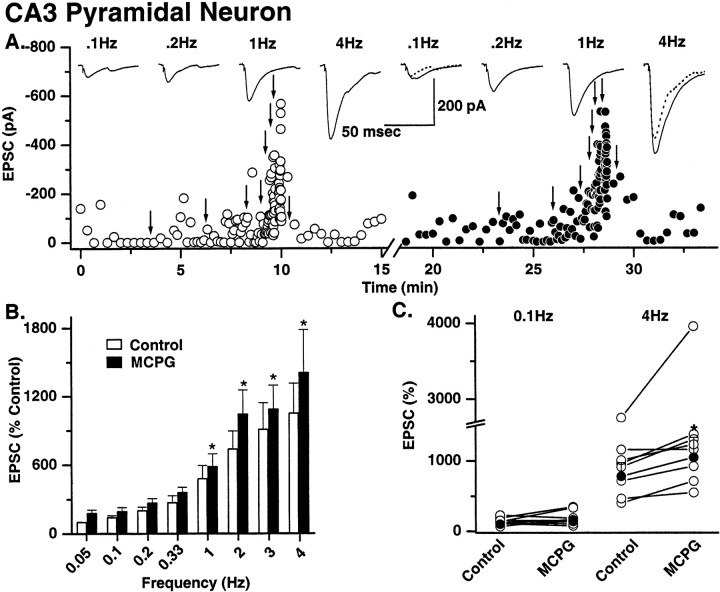Fig. 6.
Mossy fiber→pyramidal cell synapses: frequency-dependent facilitation and modulation by metabotropic glutamate receptors. A, A single representative experiment shows frequency-dependent facilitation of mossy fiber→pyramidal neuron EPSC amplitude. Left, Fifteen EPSCs were evoked under control conditions (open circles) at a starting frequency of 0.05 Hz, the stimulation frequency was then increased (indicated by arrows) to 0.1, 0.2, 0.33, 1, 2, 3, and 4 Hz, and 15 events were captured at each frequency. Averaged traces (15 events) at four sample frequencies are shown above thedot plot. The stimulus frequency was then returned to 0.05 Hz to ensure that no long-lasting change in synaptic efficacy had occurred as a result of high-frequency stimulation.Right, The solution was then exchanged for one containing MCPG (0.5 mm), and the experiment was repeated (solidcircles). MCPG enhanced the amplitude of mossy fiber→pyramidal neuron EPSCs only at frequencies of 1 Hz and above. Traces above the dot plot show averaged EPSCs from four representative frequencies. The EPSC amplitudes in the control (dotted traces) are superimposed on the 0.1 and 4 Hz data to illustrate the frequency-dependent enhancement of EPSCs by MCPG. B, Summary histogram from eight experiments shows the mean EPSC facilitation (data normalized to 0.05 Hz data). MCPG significantly enhances EPSC amplitude in all experiments only at 1 Hz and above.C, Dot plot of data from all experiments at 0.1 and 4 Hz illustrates that despite the wide range of frequency-dependent facilitation across all experiments MCPG significantly enhanced transmission at high and not low frequencies in any experiment. Asterisks indicate data significantly different from equivalent control data.

